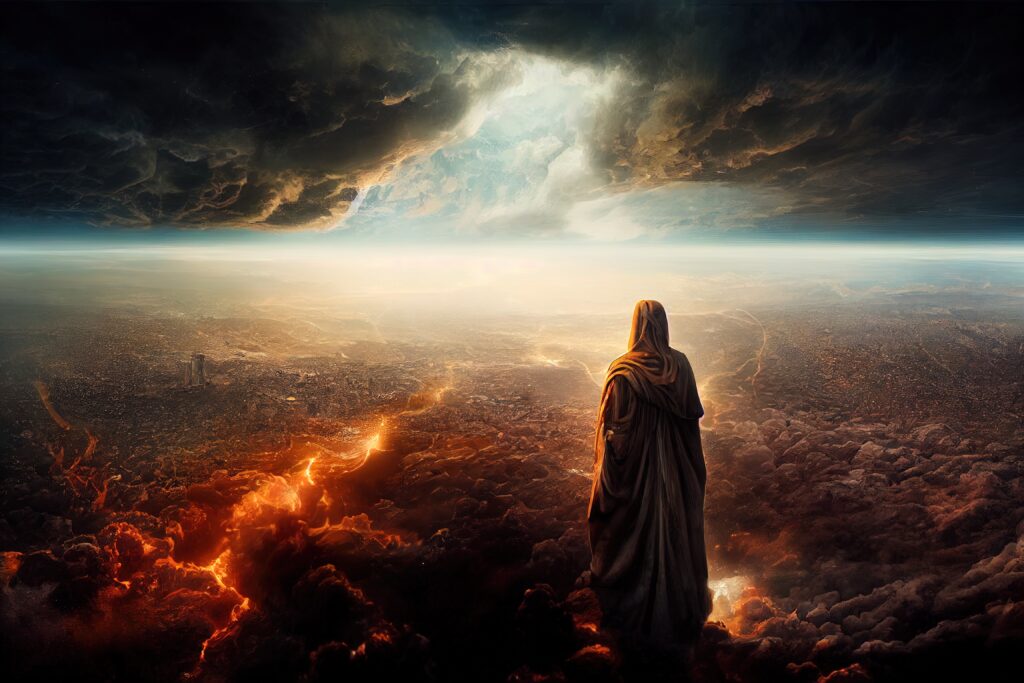
The End-time Babylon.
“Fallen, fallen is Babylon the great, she who has made all the nations drink of the wine of the passion of her sexual immorality. Rev 14:8 NASB Read also Daniel 5.
Revelation 17:1-11 will expand the concept of this here mentioned apostate religious system. Daniel 5 describes the last night of Babylon before its fall (which included the drying up of the River Euphrates also used in Revelation 17). That night, when “the writing was on the wall,” they were profaning the sacred items taken from the sanctuary. The beast in Revelation 13:6 had blasphemed the name of God and His dwelling (The heavenly sanctuary.) That night there was a drunken party taking place. For now, understand that the beast of Revelation 13 has now taken on the added description of Babylon and its fall.
The second angel’s message announces the fall, or apostasy, of Babylon and identifies it as a false religious system. In Revelation 17:5, Babylon is said to be ‘the mother of harlots.’ Her daughters must symbolize those institutions that cling to her doctrines and traditions and follow her example of sacrificing the truth and the approval of God, in order to form an unlawful alliance with the world. (The union of church controlling the state as we saw during the Middle Ages.)
The twofold repetition of the word “fallen” points to Babylon’s progressive apostasy and signifies the certainty of her full moral collapse.
Babylon is described as already fallen, but her fall is also described as future.
The end-time Babylon in Revelation is a union of false religious systems that will put themselves into the service of Satan against God’s people (see Rev. 13:11–18, Rev. 16:13, Rev. 17:5). This apostate religious union will manifest the arrogance of ancient Babylon in exalting itself above God and will seek to take His place in the world. The message of the second angel warns God’s people that this wicked system will depart further and further from the truth in consequence of her refusal of the light of the end-time gospel message. Revelation 17 will expand the meaning of this fall.
We may well ask why there are so many images of violence in this book. There is violence against Jesus (Rev 1:5, 7; 5:6; 12:11). There is violence against His followers (Rev 2:10, 13; 6:9-10). There is violence acted out by the enemies of the Lamb (13:7; 16:6; 17:16; 18:7, 20, 24). But what bothers some people the most is the divine violence in the book, of which Revelation 14:9-11 is the most graphic. How can the Lamb be, on the one hand, the victim of violence and on the other hand the one who torments and destroys?
What people often overlook is that any truly good government must at some point exercise violence in order to restrain evil. Governmental violence is not always graphic and bloody. E.g. how fast would you drive if there were no police? How much tax would you pay if it were voluntary? How eager are most convicts to stay in jail? Good governments provide a necessary restraint so we can all live together in peace.
Most people are used to this level of governmental violence. When dealing with an Adolph Hitler, Pol Pot or Vladimir Putin, however, ‘just’ violence becomes necessarily more brutal. Oppression demands justice (Rev 6:9-11; 16:6; 18:7-8), but evil never gives way voluntarily. And the greater the power and brutality of evil, the greater the force needed to undo that evil.
The images of Revelation are not pretty, but they assure us that God will do whatever it takes to end violence and oppression. The fact that divine violence is said to occur in the presence of the Lamb does not mean He enjoys horrific images. To me, it means that one who has suffered much has been placed in charge of the process. While God’s violence is necessary, it is overseen and limited by the Lamb. Why the Lamb? Only the Lamb fully understands the cost of suffering. The Lamb can be trusted to be merciful in the exercise of divine justice. The Lamb that was slain will undo evil without overkill. There will be suffering from divine justice, but not one iota more than necessary.
